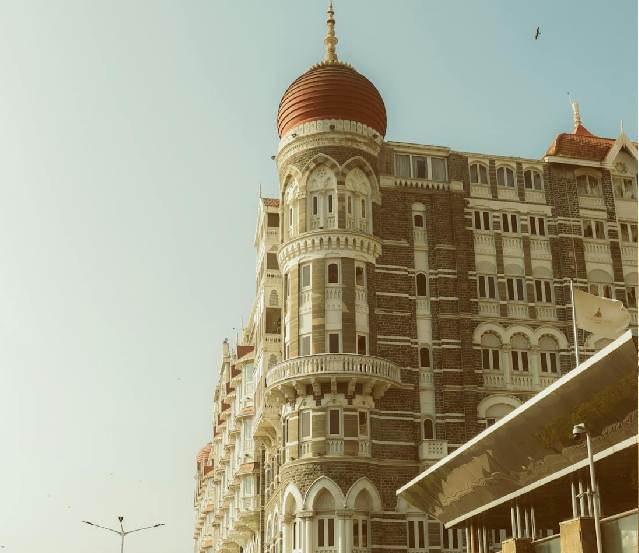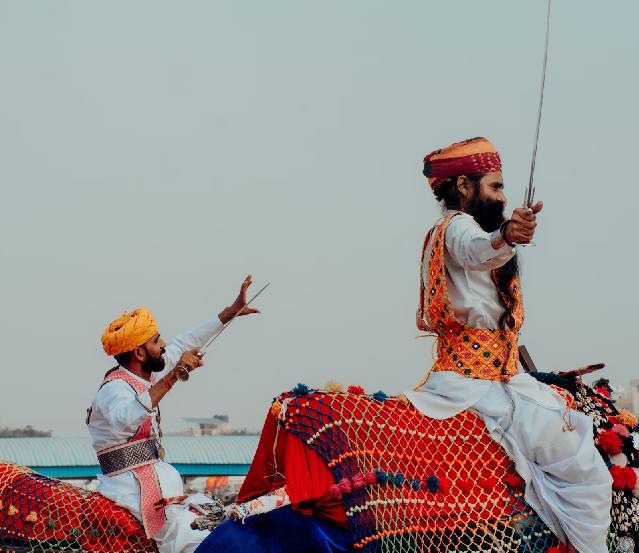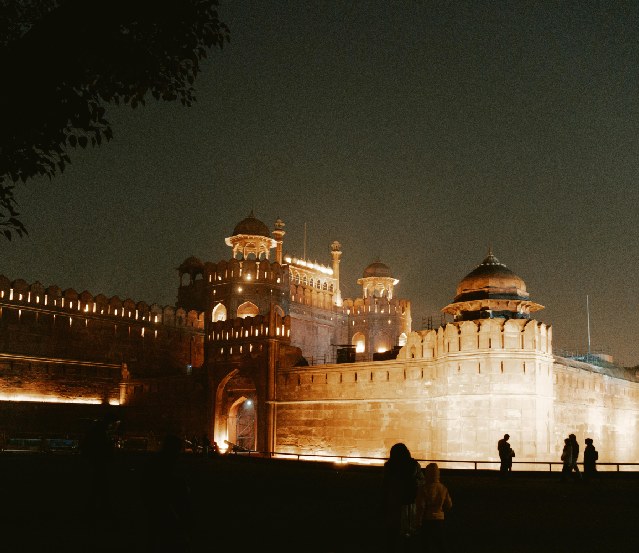Mumbai: The Ultimate India Treasure Tour Packages and Guide
Discover Mumbai’s vibrant attractions with our Mumbai Tour Packages, showcasing iconic landmarks like the Gateway of India and Chhatrapati Shivaji Maharaj Terminus. Experience guided luxury tours and savor delicious local cuisine—book your adventure today!
In this guide, we’ll explore Mumbai’s stunning landmarks, including the iconic Gateway of India and the historic Chhatrapati Shivaji Maharaj Terminus. We’ll cover how to reach Mumbai, the best time to visit, and essential tips on what to bring along. Don’t miss out on Mumbai’s famous cuisine, from savory vada pav to delectable seafood dishes. Join us as we uncover the city’s rich history and vibrant culture!
Mumbai History
The History of Mumbai: A Journey Through Time
Mumbai, often referred to as the financial capital of India, is a city steeped in history, with a narrative that spans centuries. From its humble beginnings as a cluster of islands to its evolution into a bustling metropolis, the history of Mumbai is a fascinating tapestry woven from various cultures, economies, and events. This article explores the significant phases of Mumbai’s development, the key events that shaped its character, and how it became the vibrant city we know today.
The Early Years: A Cluster of Islands
The history of Mumbai can be traced back to ancient times when it was a collection of seven islands. These islands—Colaba, Little Colaba, Mahim, Worli, Bombay, Parel, and Mazgaon—were home to various fishing communities and indigenous tribes. The earliest evidence of human habitation in this region dates back to the 2nd century BCE, with archaeological findings indicating the presence of Buddhist caves in places like Kanheri and Elephanta.
The islands were primarily inhabited by the Koli community, who were engaged in fishing and agriculture. The strategic location of Mumbai, situated along the Arabian Sea, made it a significant point for maritime trade, attracting traders and seafarers from different parts of the world.
The Arrival of the Portuguese
In the 16th century, the islands caught the attention of European powers, notably the Portuguese, who arrived in 1534. They were drawn to the region for its potential as a trading hub and its strategic naval position. The Portuguese established several forts and churches, significantly impacting the local culture and architecture. They also began to cultivate the land, introducing new agricultural practices.
The Portuguese named the islands “Bombaim,” which means “Good Bay.” However, their rule was marked by a series of conflicts with the local population, leading to a complex relationship between the colonizers and the indigenous communities.
The British Era: A New Chapter in Mumbai’s History
The turning point in Mumbai’s history came in the 17th century when the British East India Company took control of the islands. In 1661, as part of a marriage treaty between King Charles II of England and Catherine of Braganza, the islands were ceded to the British. This event marked the beginning of significant urban development in Mumbai.
The British recognized the potential of Mumbai as a trading port and began to develop its infrastructure. They constructed docks, roads, and railways, transforming the city into a key center for commerce. The introduction of the Bombay Presidency in 1687 further solidified its importance within the British Empire.
The Industrial Revolution and Urbanization
The 19th century brought about transformative changes in Mumbai’s landscape, driven by the Industrial Revolution. The city emerged as a hub for various industries, including textiles, shipping, and manufacturing. The establishment of cotton mills attracted a large workforce, leading to significant migration from rural areas to the city.
This rapid urbanization resulted in the development of neighborhoods and the expansion of Mumbai’s boundaries. However, it also led to challenges, including overcrowding, inadequate infrastructure, and public health issues. The Great Famine of 1876-78 further exacerbated these problems, leading to widespread suffering and a growing awareness of social issues.
The Rise of Nationalism and Social Reform
As the 20th century approached, Mumbai became a center for political and social movements. The city played a crucial role in the Indian independence struggle, with various leaders and activists emerging from its vibrant intellectual circles. The Indian National Congress and the All India Muslim League held significant meetings in Mumbai, shaping the course of the freedom movement.
During this period, social reformers like Jyotirao Phule and Dr. B.R. Ambedkar emerged, advocating for social justice and equality. Their efforts contributed to the awakening of the marginalized communities and laid the foundation for future social reforms in India.
The Post-Independence Era: Challenges and Growth
After India gained independence in 1947, Mumbai faced new challenges as it transitioned into a modern metropolis. The city continued to attract migrants from across the country, seeking better economic opportunities. This influx contributed to its population explosion, making it one of the most densely populated cities in the world.
The 1960s and 70s saw significant political and social upheaval, with various ethnic and linguistic groups demanding representation and rights. The formation of the state of Maharashtra in 1960, with Mumbai as its capital, marked a pivotal moment in the city’s history. The new state government initiated several development projects to address infrastructure and housing shortages.
Economic Liberalization and Globalization
The economic liberalization of the 1990s brought about a paradigm shift in Mumbai’s economic landscape. The city became a global financial hub, attracting multinational corporations and foreign investments. The establishment of the Bombay Stock Exchange and various business districts transformed Mumbai into the country’s economic powerhouse.
This period also saw the rise of the information technology sector, with numerous IT parks and startups emerging across the city. Mumbai’s diverse economy, fueled by finance, entertainment, and technology, positioned it as a key player in the global market.
Cultural Melting Pot
Mumbai’s history is also marked by its cultural diversity. The city is a melting pot of languages, religions, and traditions, with communities from all over India and beyond. This rich cultural tapestry is reflected in its festivals, cuisine, and arts. Events like Ganesh Chaturthi, Eid, and Diwali are celebrated with great fervor, showcasing the city’s inclusive spirit.
The film industry, known as Bollywood, has also played a significant role in shaping Mumbai’s identity. It has produced countless films that resonate with audiences both in India and globally, contributing to the city’s status as a cultural capital.
Contemporary Challenges and Resilience
Despite its successes, Mumbai faces numerous challenges, including infrastructure strain, housing shortages, and environmental concerns. The city is prone to flooding during the monsoon season, highlighting the need for sustainable urban planning and disaster management.
However, Mumbai’s resilience shines through in its ability to adapt and innovate. Community-driven initiatives, public-private partnerships, and government interventions have aimed to address these challenges. The city’s spirit is encapsulated in the phrase “Mumbai meri jaan,” reflecting the deep affection its residents have for their city.
Conclusion
The history of Mumbai is a testament to its evolution from a cluster of islands to a bustling metropolis. Each phase of its development has contributed to its unique character, shaped by diverse cultures, economic changes, and social movements. As Mumbai continues to grow and face modern challenges, it remains a city of resilience, innovation, and opportunity. Understanding its history not only enriches our appreciation of this vibrant city but also offers valuable insights into the broader narrative of urbanization and development in India.
Best Time To Visit Mumbai
The Best Time to Visit Mumbai
Mumbai, the bustling metropolis on India’s west coast, is a city that captivates travelers with its vibrant culture, rich history, and diverse attractions. Whether you’re drawn to its stunning architecture, thriving food scene, or the lively energy of its streets, knowing the best time to visit Mumbai can significantly enhance your experience. In this article, we will explore the climate, festivals, and events that define the best months to visit Mumbai, helping you plan an unforgettable trip.
Understanding Mumbai’s Climate
Mumbai has a tropical climate characterized by three distinct seasons: summer, monsoon, and winter. Each season offers a different experience, making it essential to consider what you want to do and see during your visit.
Summer (March to June):
- Temperature: 25°C to 35°C (77°F to 95°F)
- Weather: The summer months can be hot and humid, with temperatures rising significantly. However, this is also the time when many tourists visit due to school holidays.
Monsoon (June to September):
- Temperature: 24°C to 30°C (75°F to 86°F)
- Weather: The monsoon season brings heavy rainfall, which can lead to flooding in some areas. While the rain transforms the city and offers a unique experience, it can disrupt travel plans.
Winter (October to February):
- Temperature: 15°C to 30°C (59°F to 86°F)
- Weather: Winter is considered the best time to visit Mumbai, as the weather is pleasant and comfortable, making it ideal for sightseeing and outdoor activities.
The Best Time to Visit Mumbai
Considering the climate and local events, the best time to visit Mumbai is from October to February. This period offers a pleasant climate, with temperatures ranging from mild to warm, making it ideal for exploring the city.
October: A Fresh Start
October marks the transition from the monsoon season to winter. The rain starts to recede, and the city begins to breathe again. This month is characterized by clear skies and moderate temperatures, making it an excellent time to visit.
- Festivals: One of the highlights in October is the celebration of Navratri, a nine-night festival dedicated to the goddess Durga. Mumbai comes alive with vibrant decorations, dance performances, and cultural events. Participating in local festivities can provide insight into the rich cultural tapestry of the city.
November: Perfect Weather and Vibrant Events
November is arguably one of the best months to visit Mumbai. The weather is comfortable, with lower humidity levels and pleasant evenings.
Events and Activities: The Mumbai Film Festival often takes place in November, showcasing the best of Indian and international cinema. If you’re a film enthusiast, this is an excellent opportunity to experience the city’s cinematic culture.
Outdoor Activities: With the pleasant weather, it’s an ideal time to explore the city’s many attractions, such as the Gateway of India, Marine Drive, and Chhatrapati Shivaji Maharaj Terminus. You can also enjoy a leisurely stroll along the beaches, such as Juhu Beach and Versova Beach.
December: The Festive Spirit
December is another great month to visit Mumbai, as the city embraces the holiday spirit. The weather remains delightful, making it perfect for outdoor exploration.
Celebrations: The festive season kicks off with Christmas and New Year celebrations. Mumbai’s nightlife comes alive with parties, concerts, and events. The city’s iconic beaches and clubs are bustling with locals and tourists alike, creating a vibrant atmosphere.
Shopping and Dining: December is a great time to indulge in shopping and dining experiences. Visit local markets like Colaba Causeway and Bandra’s Linking Road for unique finds. The street food scene also thrives during this time, with stalls offering mouth-watering delicacies like vada pav, pav bhaji, and bhel puri.
January: Mild Weather and Cultural Richness
January is one of the coolest months in Mumbai, making it comfortable for travelers. The average temperature hovers around 20°C to 25°C (68°F to 77°F), which is perfect for exploring the city’s attractions.
Cultural Events: The Kala Ghoda Arts Festival, usually held in February, starts gaining momentum in January. This vibrant festival showcases visual arts, music, and dance performances, reflecting the creative spirit of Mumbai. It’s a great time to immerse yourself in the local art scene.
Outdoor Exploration: Take advantage of the mild weather to visit parks and gardens like Sanjay Gandhi National Park and the Hanging Gardens. A visit to the Elephanta Caves, a UNESCO World Heritage Site, is also more enjoyable during this time.
February: The Festive Finale
February is an excellent month to visit Mumbai, as the weather remains pleasant and the city is vibrant with cultural activities.
Cultural Highlights: The Kala Ghoda Arts Festival officially kicks off in early February, drawing art lovers and visitors from across the globe. This week-long festival features art installations, performances, and workshops, providing a rich cultural experience.
Travel Opportunities: With the weather still mild, it’s a good time to take day trips to nearby attractions like Lonavala and Khandala, where you can enjoy nature and explore hill stations.
Off-Peak Seasons: March to September
While October to February is the best time to visit Mumbai, the off-peak months from March to September can also offer unique experiences, though with a few considerations.
March: Transition to Heat
March marks the beginning of summer, with temperatures starting to rise. While the weather is still manageable, it can get hot, especially in the afternoons.
- Activities: March is a good time for visiting museums and art galleries, such as the Prince of Wales Museum and Chhatrapati Shivaji Maharaj Vastu Sangrahalaya, to escape the heat.
April to June: Hot and Humid
From April to June, temperatures can soar, often exceeding 35°C (95°F). The humidity can also be quite high, making outdoor activities less comfortable.
- Indoor Activities: If you visit during these months, consider focusing on indoor attractions, such as shopping malls, cinemas, and air-conditioned restaurants. Additionally, you might find better deals on accommodations and attractions due to lower tourist traffic.
Monsoon Season: June to September
The monsoon season from June to September brings heavy rains, which can be a double-edged sword for travelers.
Pros: The city transforms into a lush green landscape, and the rain brings a refreshing change to the hot climate. Monsoon festivals, such as Raksha Bandhan, can also offer a glimpse into local traditions.
Cons: Heavy rainfall can lead to flooding and transportation disruptions, making travel more challenging. Outdoor activities may be limited, so it’s essential to plan accordingly if you choose to visit during this time.
Tips for Visiting Mumbai
Plan Ahead: Regardless of when you visit, planning your itinerary ahead of time can help you make the most of your trip. Consider local events and festivals that align with your interests.
Stay Hydrated: The tropical climate can be dehydrating, especially during the hotter months. Carry water with you and stay hydrated while exploring.
Dress Appropriately: Light, breathable clothing is advisable, especially in the summer. If visiting during the monsoon, be prepared with waterproof gear and footwear.
Explore Local Cuisine: Mumbai is renowned for its diverse food scene. Don’t miss the chance to indulge in street food and local delicacies throughout the year.
Transport Options: Mumbai’s local train system is efficient but can be crowded during peak hours. Alternatively, consider using ride-hailing apps for convenience.
Conclusion
In conclusion, the best time to visit Mumbai is undoubtedly between October and February, when the weather is most pleasant and the city is alive with cultural events and festivities. Each month offers its own unique experiences, allowing you to immerse yourself in the vibrant tapestry of Mumbai’s life. Whether you’re exploring its historical sites, enjoying local cuisine, or participating in festivals, the energy and diversity of Mumbai promise an unforgettable journey. So, pack your bags and get ready to explore one of India’s most dynamic cities!
How To Reach Mumbai
How to Reach Mumbai: Your Comprehensive Guide
Mumbai, the bustling financial capital of India, is a city that attracts millions of visitors each year. Whether you’re drawn to its vibrant culture, historical landmarks, or business opportunities, knowing how to reach Mumbai efficiently is essential. This article will guide you through the best ways to reach Mumbai from three key locations: Delhi, Rajasthan, and Varanasi, along with associated costs.
How to Reach Mumbai from Delhi
1. By Air
Flight Duration: Approximately 2 hours
Average Cost: ₹3,000 – ₹7,000 (one way)
One of the fastest ways to reach Mumbai from Delhi is by air. Multiple airlines operate daily flights between Indira Gandhi International Airport (DEL) in Delhi and Chhatrapati Shivaji Maharaj International Airport (BOM) in Mumbai.
Steps:
- Booking: You can book flights through various online platforms like MakeMyTrip, Cleartrip, or directly through airline websites such as IndiGo, Air India, and Vistara.
- Airport Transfer: Upon arrival at Mumbai airport, you can hire a taxi, use ride-hailing apps like Uber or Ola, or take the airport shuttle to reach your destination.
2. By Train
Train Duration: 16-20 hours (depending on the train)
Average Cost: ₹600 – ₹2,500 (Sleeper class to AC tier)
Traveling by train is another popular option, offering a scenic view of the countryside. The major railway stations in Delhi—New Delhi Railway Station (NDLS) and Hazrat Nizamuddin Railway Station (HZM)—connect to several trains heading to Mumbai, primarily to Chhatrapati Shivaji Maharaj Terminus (CST) and Mumbai Lokmanya Tilak Terminus (LTT).
Steps:
- Booking: Train tickets can be booked via the IRCTC website or mobile app. Popular trains include the Rajdhani Express, Nanded Express, and August Kranti Rajdhani Express.
- Travel Tip: Book your tickets in advance, especially during peak seasons, to secure your preferred class.
3. By Road
Distance: Approximately 1,450 km
Travel Duration: 24-30 hours (by bus or car)
Average Cost: ₹1,500 – ₹3,000 (by bus)
Driving from Delhi to Mumbai can be an adventurous road trip, offering a chance to explore various states along the way. However, it’s important to be prepared for long hours on the road.
Steps:
- Bus Services: Several private bus operators run services between Delhi and Mumbai. You can book tickets online through platforms like RedBus or Yatra.
- Self-Driving: If you choose to drive, take the NH 48 route, which is the most direct and well-maintained highway.
How to Reach Mumbai from Rajasthan
1. By Air
Flight Duration: Approximately 1 hour 30 minutes
Average Cost: ₹2,500 – ₹6,000 (one way)
Rajasthan has several airports, with the most notable being Jaipur International Airport (JAI). Direct flights from Jaipur to Mumbai are frequent, making it a convenient option.
Steps:
- Booking: Use flight aggregator websites or airline websites for booking.
- Transfer to the City: Upon landing in Mumbai, take a taxi or ride-hailing service to your accommodation.
2. By Train
Train Duration: 12-18 hours (depending on the train)
Average Cost: ₹500 – ₹2,000 (Sleeper class to AC tier)
Trains connect various cities in Rajasthan to Mumbai, with frequent services from cities like Jaipur, Udaipur, and Jodhpur.
Steps:
- Booking: You can book tickets through the IRCTC website or mobile app. Popular trains include the Maharashtra Sampark Kranti Express and Jodhpur-Mumbai Express.
- Travel Tip: Overnight trains are a comfortable option, allowing you to travel while you sleep.
3. By Road
Distance: Varies by city (e.g., Jaipur to Mumbai is around 1,500 km)
Travel Duration: 24-30 hours (by bus or car)
Average Cost: ₹1,000 – ₹2,500 (by bus)
Traveling by road can be a great way to experience the diverse landscapes of Rajasthan and Maharashtra.
Steps:
- Bus Services: Numerous private and state-run buses operate between Rajasthan and Mumbai. Online booking is available through platforms like RedBus.
- Self-Driving: Driving can be enjoyable if you plan your route along the NH 48 or NH 62, which are well-maintained highways.
How to Reach Mumbai from Varanasi
1. By Air
Flight Duration: Approximately 2 hours
Average Cost: ₹3,000 – ₹7,000 (one way)
Flying is the quickest and most convenient option for traveling from Varanasi to Mumbai. Lal Bahadur Shastri International Airport (VNS) in Varanasi has direct flights to Chhatrapati Shivaji Maharaj International Airport (BOM).
Steps:
- Booking: Flights can be booked via travel websites or directly through airlines like IndiGo and Air India.
- City Transfer: Once in Mumbai, use local transport options like taxis or apps for a hassle-free journey.
2. By Train
Train Duration: 24-30 hours (depending on the train)
Average Cost: ₹800 – ₹2,500 (Sleeper class to AC tier)
Train travel from Varanasi to Mumbai provides a scenic view of northern and western India. Varanasi Junction (VNS) connects to various trains heading to Mumbai.
Steps:
- Booking: Use the IRCTC website or mobile app to book your tickets. Popular trains include the Banaras-Mumbai Express and Maharashtra Sampark Kranti Express.
- Tip: As with other routes, booking in advance is advisable to secure your preferred seats.
3. By Road
Distance: Approximately 1,500 km
Travel Duration: 30-35 hours (by bus or car)
Average Cost: ₹1,500 – ₹3,000 (by bus)
Road travel from Varanasi to Mumbai can be long but is an option if you enjoy road trips.
Steps:
- Bus Services: Look for long-distance bus operators that run services from Varanasi to Mumbai. Booking can be done through platforms like RedBus.
- Self-Driving: If you prefer driving, plan your route carefully and take regular breaks, as the journey can be exhausting.
Comparison of Travel Options
| From | Mode | Duration | Average Cost |
|---|---|---|---|
| Delhi | Air | 2 hours | ₹3,000 – ₹7,000 |
| Train | 16-20 hours | ₹600 – ₹2,500 | |
| Road | 24-30 hours | ₹1,500 – ₹3,000 | |
| Rajasthan | Air | 1.5 hours | ₹2,500 – ₹6,000 |
| Train | 12-18 hours | ₹500 – ₹2,000 | |
| Road | 24-30 hours | ₹1,000 – ₹2,500 | |
| Varanasi | Air | 2 hours | ₹3,000 – ₹7,000 |
| Train | 24-30 hours | ₹800 – ₹2,500 | |
| Road | 30-35 hours | ₹1,500 – ₹3,000 |
Tips for Traveling to Mumbai
Book in Advance: Regardless of your mode of transport, booking in advance can help you secure the best rates and preferred timings.
Travel Insurance: Consider purchasing travel insurance, especially if you’re flying, to cover any unforeseen events.
Local Transport in Mumbai: Once you arrive, familiarize yourself with local transport options. Mumbai’s local trains, buses, and auto-rickshaws are widely used, but taxis and ride-hailing apps offer more comfort.
Stay Hydrated: Mumbai can be humid, so ensure you drink plenty of water, especially if you arrive during the summer months.
Explore Local Cuisine: Take the opportunity to indulge in Mumbai’s famous street food and local dishes, such as vada pav, pav bhaji, and seafood.
Plan Your Itinerary: Mumbai is a sprawling city with a wealth of attractions. Planning your itinerary can help you make the most of your visit.
Conclusion
Reaching Mumbai from Delhi, Rajasthan, or Varanasi is convenient and offers a variety of travel options to suit different preferences and budgets. Whether you choose to fly, take a train, or drive, each journey presents an opportunity to experience the diverse landscapes of India. With this guide, you can confidently plan your trip to Mumbai, ensuring an enjoyable and memorable experience in this vibrant city. So pack your bags, set your itinerary, and get ready to explore the heart of India!
Famous Places In Mumbai
Famous Places to Visit in Mumbai: A Complete Guide
Mumbai, often called the city of dreams, is a vibrant metropolis brimming with culture, history, and energy. From iconic landmarks to hidden gems, Mumbai offers a plethora of attractions that cater to every traveler. In this article, we will explore some of the famous places to visit in Mumbai, including how to reach them, their opening and closing times, ticket prices, and public holidays. Whether you’re a first-time visitor or a seasoned traveler, this guide will help you navigate the best of Mumbai.

1. Gateway of India
Overview
The Gateway of India is an iconic arch monument located on the waterfront in Apollo Bunder, South Mumbai. Built in 1924 to commemorate the visit of King George V and Queen Mary to India, it is one of Mumbai’s most recognizable landmarks.
How to Reach
- By Train: The nearest local train station is Churchgate on the Western Line. From there, take a taxi or an auto-rickshaw.
- By Metro: The nearest metro station is Chhatrapati Shivaji Maharaj Terminus (CST). From CST, it’s a short taxi ride.
- By Bus: Various BEST buses connect to the Gateway, with stops at CSMT and other nearby locations.
Opening and Closing Times
- Open: 24 hours
- Best Time to Visit: Early morning or late evening for stunning views of the sea.
Ticket Price
- Entry Fee: Free
Holidays
- Open on Holidays: Yes, but it can be crowded during public holidays and festivals.

2. Marine Drive
Overview
Marine Drive, also known as the Queen’s Necklace, is a 3.6 km-long boulevard that stretches along the coastline of South Mumbai. The scenic view of the Arabian Sea and the city’s skyline makes it a popular spot for both locals and tourists.
How to Reach
- By Train: Get off at Churchgate station and walk towards the sea.
- By Bus: Multiple BEST bus routes service Marine Drive.
Opening and Closing Times
- Open: 24 hours
- Best Time to Visit: Evening, for the sunset views and to experience the bustling local life.
Ticket Price
- Entry Fee: Free
Holidays
- Open on Holidays: Yes, the promenade is a favorite among people looking to unwind.
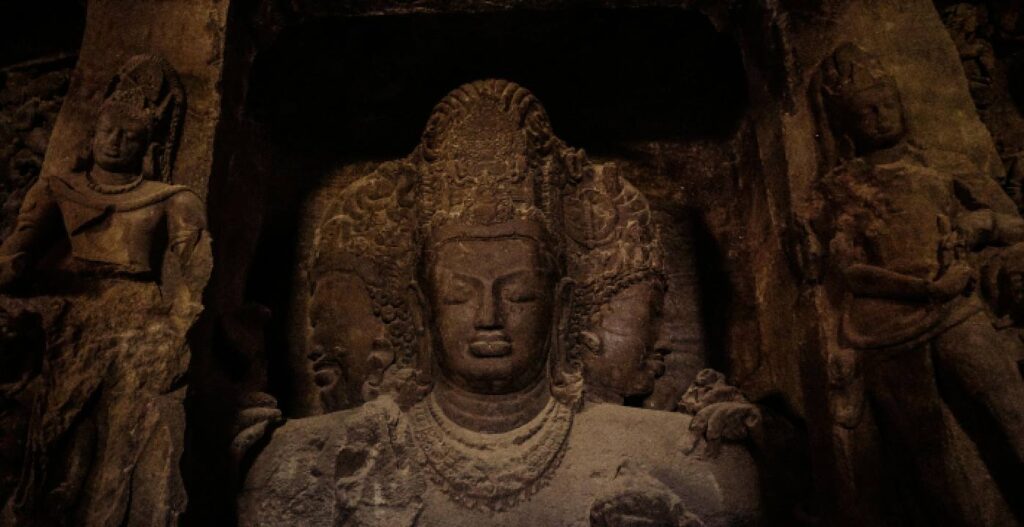
3. Elephanta Caves
Overview
Located on Elephanta Island, these ancient rock-cut caves are dedicated to Lord Shiva and are famous for their intricate sculptures. They date back to the 5th to 8th centuries and are another UNESCO World Heritage Site.
How to Reach
- By Ferry: Ferries to Elephanta Island depart from the Gateway of India. The ferry ride takes about 1 hour.
- Cost: Round trip fare is approximately ₹200-₹300.
Opening and Closing Times
- Open: 9:00 AM to 5:30 PM
- Best Time to Visit: Morning hours to avoid the midday heat.
Ticket Price
- Entry Fee: ₹40 for Indians and ₹600 for foreign tourists. Additional charges for camera use.
Holidays
- Closed on: Open on most public holidays, but check local listings for specific closures.
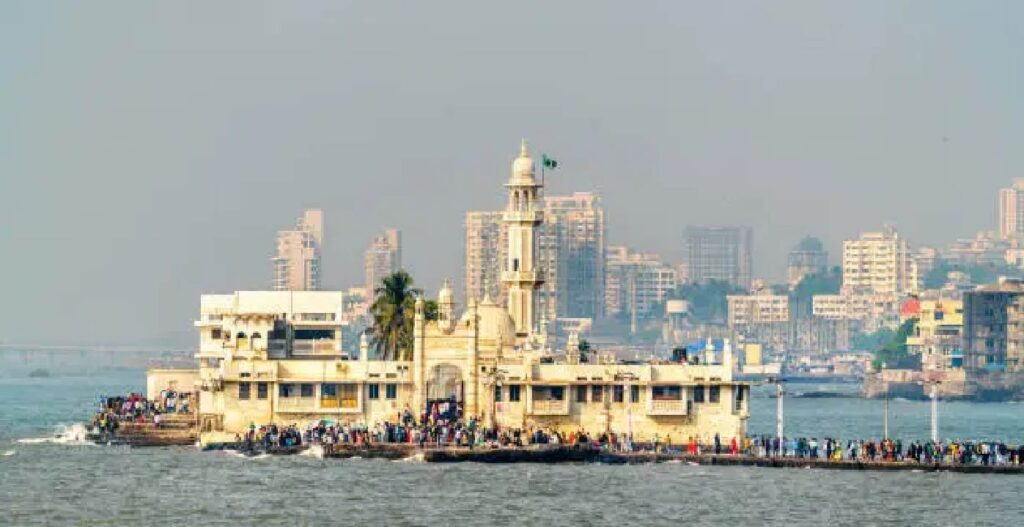
4. Haji Ali Dargah
Overview
Haji Ali Dargah is a mosque and tomb located on an islet off the coast of Worli. It is one of the most famous religious places in Mumbai, attracting visitors of all faiths.
How to Reach
- By Train: The nearest station is Mahalaxmi. From there, take a taxi or auto-rickshaw.
- By Bus: Several BEST bus routes service Haji Ali.
Opening and Closing Times
- Open: 6:30 AM to 10:00 PM
- Best Time to Visit: Early morning or late evening for a serene experience.
Ticket Price
- Entry Fee: Free
Holidays
- Open on Holidays: Yes, but during special religious occasions, it can be crowded.

5. Juhu Beach
Overview
Juhu Beach is one of the most famous beaches in Mumbai, known for its lively atmosphere and beautiful sunsets. It’s a favorite among locals for evening strolls and street food.
How to Reach
- By Train: The nearest station is Juhu on the Western Line. A taxi or auto-rickshaw will get you to the beach.
- By Bus: Various BEST buses serve Juhu.
Opening and Closing Times
- Open: 24 hours
- Best Time to Visit: Evenings for street food and sunset views.
Ticket Price
- Entry Fee: Free
Holidays
- Open on Holidays: Yes, but it can get crowded, especially during festivals.

6. Sanjay Gandhi National Park
Overview
Located in Borivali, this sprawling national park is a haven for nature lovers and wildlife enthusiasts. It houses the famous Kanheri Caves, which date back to the 1st century BCE.
How to Reach
- By Train: Get off at Borivali station. From there, take a taxi or auto-rickshaw to the park.
- By Bus: Several BEST buses connect to the park.
Opening and Closing Times
- Open: 7:30 AM to 5:30 PM
- Best Time to Visit: Early morning for wildlife spotting.
Ticket Price
- Entry Fee: ₹53 for adults, ₹27 for children (additional fees for cave entry and vehicles).
Holidays
- Open on Holidays: Yes, but it can be crowded on weekends.
Conclusion
Mumbai is a city that offers an incredible variety of experiences, from historical landmarks to serene beaches and lush national parks. Each famous place to visit in Mumbai has its unique charm, making it essential for visitors to plan their itineraries wisely. By considering how to reach these attractions, their opening hours, ticket prices, and holiday timings, you can make the most of your visit to this vibrant city. So pack your bags, grab your camera, and get ready to explore the rich tapestry of Mumbai!
Famous Food Of Mumbai
Famous Food of Mumbai: A Culinary Delight
Mumbai, the bustling metropolis on India’s west coast, is not just known for its iconic skyline and vibrant culture, but also for its extraordinary food scene. The city boasts a rich tapestry of flavors that reflect its diverse population, history, and traditions. From street food to fine dining, the famous food of Mumbai captures the essence of its lively spirit. In this article, we will explore why Mumbai’s food is so famous, highlight some must-try dishes, and provide an overview of their prices.
Why Mumbai’s Food is Famous
1. Diverse Culinary Influences
Mumbai is a melting pot of cultures, and this diversity is beautifully represented in its cuisine. With influences from Gujarati, Maharashtrian, Parsi, South Indian, and even Jewish traditions, the city offers a wide range of flavors and cooking styles. The food reflects the various communities that have settled in the city over the years, making it a gastronomic paradise.
2. Street Food Culture
One of the standout features of Mumbai’s culinary scene is its vibrant street food culture. The city is home to countless street vendors offering quick bites that are both delicious and affordable. Street food is a staple for many Mumbaikars, and it plays a crucial role in the city’s culinary identity. Eating at these stalls provides not just a meal, but a cultural experience, with each vendor often having their own unique twist on classic dishes.
3. Fusion and Innovation
Mumbai’s food scene is also known for its innovative fusion dishes. Chefs and home cooks alike are not afraid to experiment, resulting in new culinary creations that blend traditional recipes with modern techniques. This creativity keeps the food scene dynamic and ever-evolving, drawing food lovers from around the world.
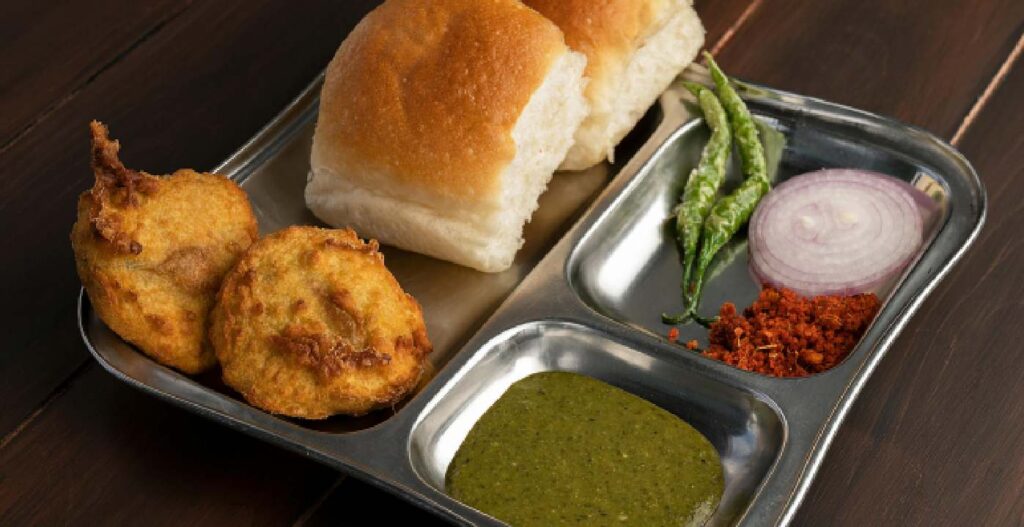
Must-Try Dishes in Mumbai
1. Vada Pav
Often referred to as Mumbai’s beloved burger, Vada Pav consists of a spicy potato fritter (vada) sandwiched between two slices of bread (pav), usually served with chutneys and fried green chili. It’s a quintessential street food that embodies the essence of Mumbai.
Price: ₹20 to ₹50 per serving
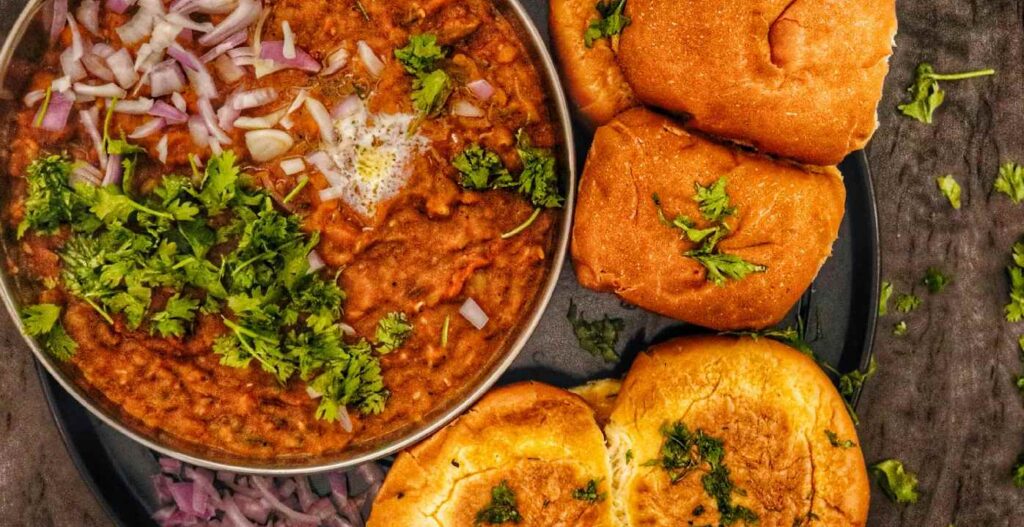
2. Pav Bhaji
A delightful mix of mashed vegetables cooked in spices and served with buttered pav, Pav Bhaji is a popular snack that originated in Mumbai. It’s rich, flavorful, and perfect for a quick meal.
Price: ₹50 to ₹100 for a plate
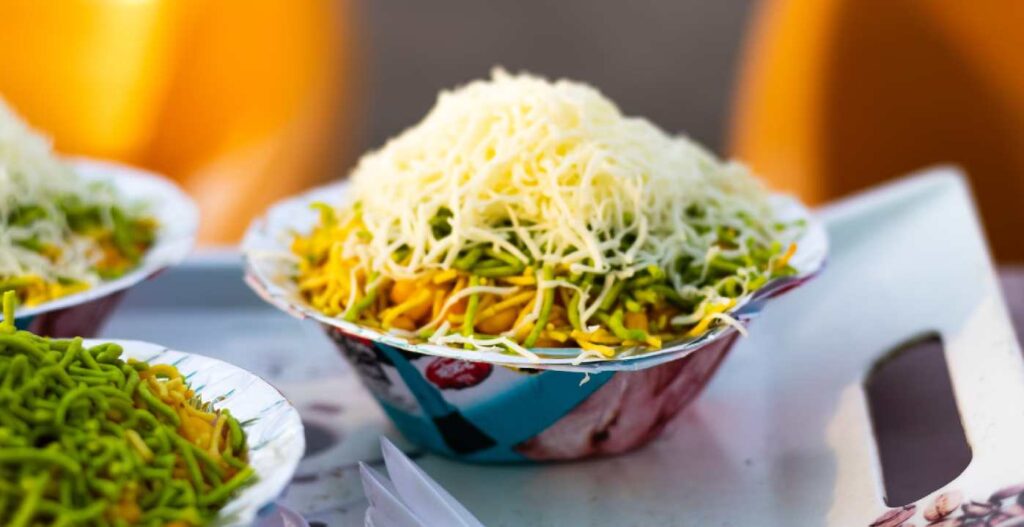
3. Bhel Puri
This light and tangy snack is made with puffed rice, vegetables, and tangy tamarind sauce. Bhel Puri is often enjoyed on the beaches of Juhu and Chowpatty, making it a favorite among locals and tourists alike.
Price: ₹30 to ₹60 per serving

4. Dhokla
Originally from Gujarat, Dhokla has found a special place in Mumbai’s food scene. This steamed savory cake made from fermented rice and chickpea batter is light and fluffy, often served with green chutney.
Price: ₹40 to ₹80 for a plate
5. Misal Pav
A spicy curry made from sprouted lentils, Misal Pav is a traditional Maharashtrian dish that has gained popularity across the city. It’s typically served with pav and topped with chopped onions and lemon.
Price: ₹60 to ₹100 for a serving
Where to Eat
Mumbai offers a mix of street vendors, local eateries, and fine dining options. Here are a few recommended places to try the famous food of Mumbai:
Anand Stall (Vada Pav and Pav Bhaji): Located near Mithibai College in Vile Parle, this stall is a favorite among students and locals.
Aaram Vada Pav: Situated near CST Station, it is renowned for its authentic Vada Pav.
Cannon Pav Bhaji: Located at the CST area, it’s famous for its delicious Pav Bhaji served with butter.
Ashok Vada Pav: Located in Dadar, it’s known for its spicy and flavorful Vada Pav.
Juhu Beach: Visit this iconic spot to enjoy Bhel Puri and other local snacks while enjoying the sea view.
Conclusion
The famous food of Mumbai is a true reflection of the city’s rich culture and diversity. With a plethora of dishes to choose from, ranging from spicy street snacks to sweet delicacies, there’s something to satisfy every palate. The affordability of Mumbai’s food scene makes it accessible to all, allowing you to explore the city’s flavors without breaking the bank. Whether you’re indulging in Vada Pav or savoring a plate of Pav Bhaji, each bite is a celebration of Mumbai’s vibrant culinary heritage. So, the next time you find yourself in this bustling city, be sure to embark on a culinary journey that you won’t soon forget!
What To Take In Mumbai Or Not
What to Take on Your Mumbai Tour: Essentials and Tips
Planning a trip to Mumbai can be exciting yet overwhelming, especially with the city’s vibrant culture, diverse climate, and myriad attractions. Knowing what to take on your Mumbai tour, including what to wear during different seasons and where to stay, can enhance your travel experience. Here’s a comprehensive guide to help you prepare for your Mumbai adventure.
What to Wear in Mumbai: Seasonal Guide
1. Summer (March to June)
Mumbai experiences hot and humid weather during the summer months, with temperatures often exceeding 35°C (95°F).
What to Wear:
- Lightweight Clothing: Opt for breathable fabrics like cotton and linen. Loose-fitting clothes will help keep you cool.
- Sun Protection: A wide-brimmed hat, sunglasses, and sunscreen are essential to protect yourself from the harsh sun.
- Footwear: Comfortable sandals or breathable sneakers are ideal for walking around the city.
Packing Tips:
- A light scarf can be useful for covering your shoulders when visiting religious sites.
- Consider packing a reusable water bottle to stay hydrated.
2. Monsoon (June to September)
The monsoon season brings heavy rainfall to Mumbai, transforming the city into a lush green paradise.
What to Wear:
- Waterproof Gear: A light rain jacket or a poncho is crucial. An umbrella is also handy, but ensure it’s compact.
- Quick-Drying Fabrics: Wear synthetic or quick-drying materials to avoid discomfort from humidity.
- Footwear: Waterproof sandals or rubber shoes are recommended to navigate puddles and wet streets.
Packing Tips:
- Carry a small waterproof bag to protect your electronics and valuables from rain.
- Consider bringing extra pairs of socks and shoes in case you get wet.
3. Winter (October to February)
Mumbai’s winter is mild, with temperatures ranging from 15°C (59°F) to 30°C (86°F). While it’s pleasant, it can still be a bit chilly in the evenings.
What to Wear:
- Layering: Lightweight sweaters or jackets will keep you comfortable during cooler evenings.
- Casual Attire: Comfortable clothes are ideal for sightseeing, including t-shirts, jeans, and light trousers.
- Footwear: Comfortable walking shoes or loafers will serve you well.
Packing Tips:
- A light shawl or scarf can be useful for evenings or when visiting air-conditioned places.
Where to Stay in Mumbai: Luxury Hotels and Hostels
Mumbai offers a wide range of accommodation options, from luxury hotels to budget-friendly hostels.
Luxury Hotels
The Taj Mahal Palace
- Location: Colaba
- Price: Starting from ₹25,000 per night
- Overview: This iconic hotel combines history with modern luxury. Guests can enjoy stunning views of the Gateway of India and luxurious amenities, including a spa and several fine dining options.
The Oberoi Mumbai
- Location: Nariman Point
- Price: Starting from ₹20,000 per night
- Overview: Known for its exceptional service, The Oberoi offers elegant rooms and a beautiful view of the Arabian Sea. Facilities include a swimming pool, fitness center, and a variety of dining options.
JW Marriott Mumbai Juhu
- Location: Juhu Beach
- Price: Starting from ₹15,000 per night
- Overview: This beachfront hotel is perfect for those who want to relax by the sea. It features luxurious rooms, a lavish spa, and a variety of dining options, including Indian and international cuisine.
Budget-Friendly Hostels
Zostel Mumbai
- Location: Juhu
- Price: Starting from ₹500 per night (dormitory)
- Overview: A popular choice among backpackers, Zostel offers a vibrant atmosphere, clean facilities, and organized events to help travelers meet each other.
Hostel Mantra
- Location: Bandra
- Price: Starting from ₹700 per night (dormitory)
- Overview: This cozy hostel provides a homely environment with modern amenities. Guests can enjoy a communal kitchen, a lounge area, and easy access to local attractions.
The Backpacker’s Hostel
- Location: Andheri
- Price: Starting from ₹600 per night (dormitory)
- Overview: Close to the Western suburbs, this hostel offers a relaxed vibe and friendly staff. It’s an excellent base for exploring nearby attractions and enjoying Mumbai’s nightlife.
What to Pack for Your Mumbai Tour
In addition to clothing and accommodations, consider packing these essentials:
- Documents: Ensure you have a copy of your passport, visa, and travel insurance. Keep a digital copy on your phone as well.
- Chargers and Adapters: India uses Type C and Type D power plugs, so pack a universal adapter if necessary.
- First Aid Kit: Basic medications for headaches, allergies, or stomach issues can be handy.
- Snacks: Carry some light snacks for when you’re on the go, especially if you plan to explore remote areas.
Conclusion
Mumbai is a city that blends tradition with modernity, offering an array of experiences for every traveler. Knowing what to wear and where to stay will help you navigate your tour with ease. Whether you opt for luxury hotels or budget-friendly hostels, ensure you pack appropriately for the season. With the right preparations, your Mumbai adventure is sure to be memorable!
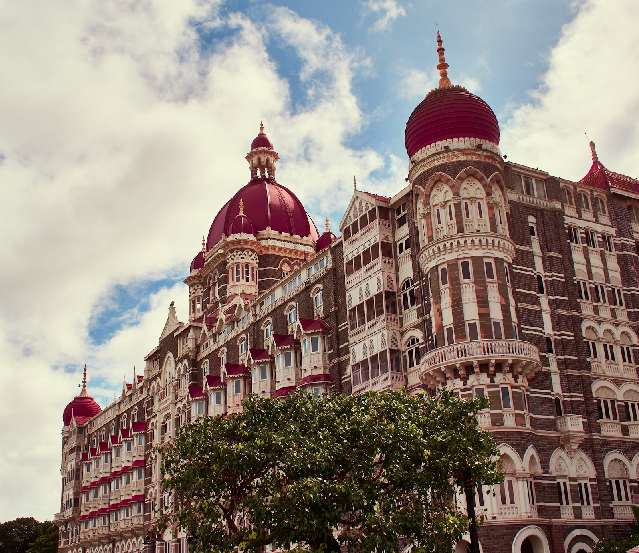
Mumbai is a vibrant city on the west coast of India, along the Arabian Sea, approximately 500 kilometers south of New Delhi. As of 2024, it has an estimated population of around 20 million, making it one of the world’s most populous cities. The literacy rate is about 89.7%, well above the national average.
Mumbai Area: 603 Sq. Km.
Mumbai Tour PAckages
More Tour Packages : Mumbai Tour Packages, Best Time to Visit Mumbai, How To reach Mumbai, Delhi Mumbai, Mumbai Tour Packages, Mumbai day tour package, Famous Places in Mumbai, Mumbai History, Famous Food Of Mumbai, Mumbai holiday package, Mumbai Sighseeing
Destinations
Head Office
L-2 Shaheed Nagar
282001- Agra
Get In Touch
Based On 1630 Reviews
